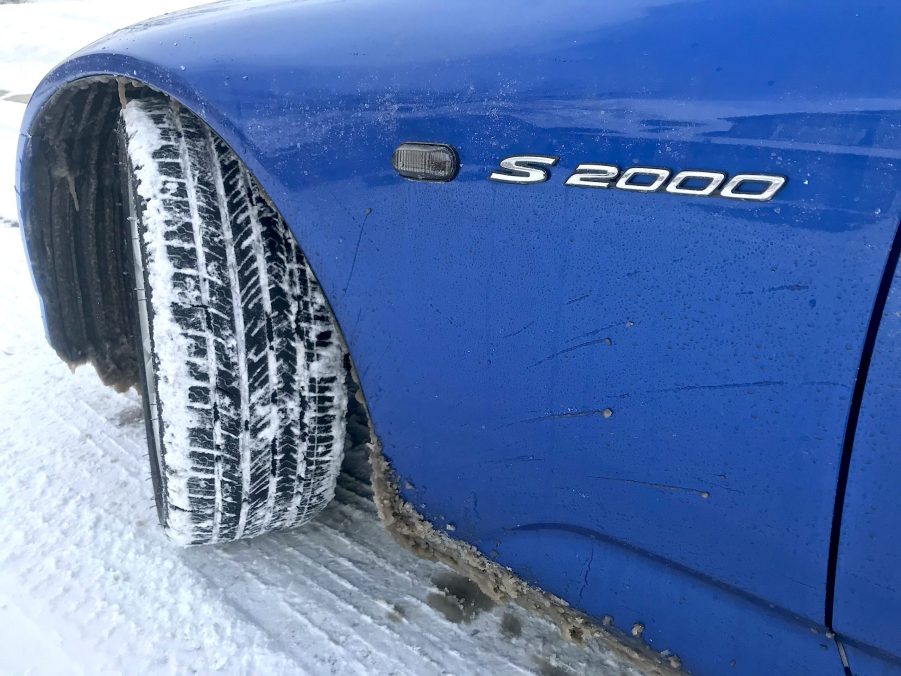
Driving a Honda S2000 in 0-Degree Weather Isn’t That Cool
“This is a stupid idea,” I thought to myself as I pushed the red ignition button on my Honda S2000’s dashboard. This wasn’t the first time I had driven the car in snowy weather, but it was definitely the coldest. The outside temperature gauge in the instrument panel read “0 degrees” and I could see my breath while sitting inside the car. As I reversed out of my parking space, I knew that I would be in for a cold and daunting ride.
The Honda S2000 doesn’t like cold weather

The Honda S2000 is a joy to drive when its engine and tires are warmed up to the proper temperatures, but when they are cold, the car feels clunky. When starting out in a cold S2000 the car’s shifter feels choppy and the throttle feels a little lazy – even with warm outside temperatures. But when it’s 0 degrees outside, I could tell my poor blue car didn’t even want to be awake.
However, I had an errand to run and no press car to drive, so my trusty S2000 had to get me there come snow or freezing temps. Pulling out of my apartment complex and out onto the main road was an adventure in itself. When making a right turn with no other cars in sight, my car’s rear-end immediately kicked out and I was almost pointing the other direction. Fortunately, I counter-steered and stopped the car before it could. It was at that moment that I knew this adventure was going to be (kind of) fun.
The Michelin Pilot Sport All Season 4 tires did their job as best they could

For context, it had snowed a couple of inches the night before so the ground was still packed with fresh powder, which is great for skiing but not so great for a rear-drive car with a short wheelbase. Fortunately, the Michelin Pilot Sport All-Season 4 tires that I have on the car hold up well in the winter.
If you’re unfamiliar with them, the Michelin Pilot Sport All-Season 4 is a high-performance all-season tire that’s made for sports cars and sedans, including some supercars. In fact, the C8 Corvette comes standard with them, so that says something. So far, in my real-world testing, they have handled extremely well, but I wasn’t sure how well they do in single-digit temperatures.
Would they turn into hockey pucks and have my S2000 spinning into a ditch on the way to the grocery store? Would they not grip well enough in the snow and cause me to abort my errands altogether? These are questions I asked myself as I set out on my drive, but luckily, the answer was a resounding “no.”
Instead, I was able to get to my destinations just fine. But I will say that it was not without some drama, mainly when accelerating. Every time I would stop and then accelerate, I found out that first gear was completely useless as the tires would spin and I would go nowhere until I shifted into second. There were a couple of times where I got perpendicular, but counter-steering and braking are key.
Of course, the car’s power delivery is likely to blame, but it was also clear that the tires didn’t grip as well as genuine winter tire probably would have. Although, once I got the car going, all was well. Even when coming to a stop, the tires did their job and gripped whatever asphalt they could.
The tires are great, but the S2000 is still a pain to drive in the snow

While I could go on about how great the Michelin tires are, they’re not completely perfect. They are definitely less compliant in freezing temps and I wouldn’t drive through a snowstorm with them. So, if your area is plagued with heavy snowfall in the winter, buy winter tires.
Also, driving an S2000 in 0-degree weather is not recommended. It’s possible, just like it is with any other car, but now I know why Colorado is overrun by Subarus and Jeeps. Those types of cars just handle the winter weather better and can exit my apartment complex without spinning out. Case in point, if you own an S2000, drive it during the warmer months. That’s a far better idea.



